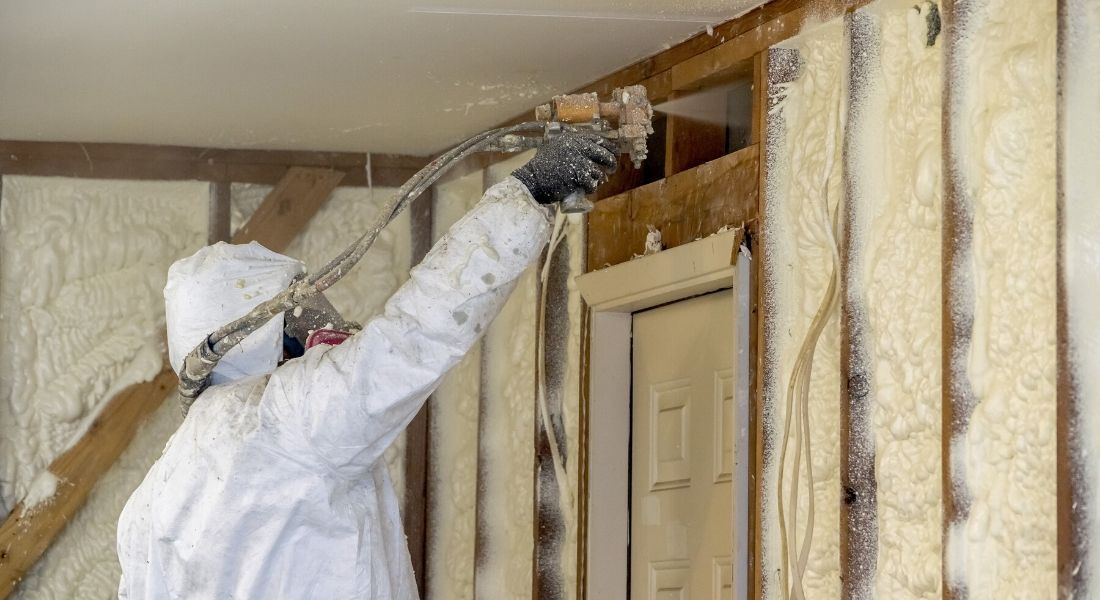If you're embarking on a DIY project involving spray foam insulation or sealing gaps with expanding foam, understanding how long it takes to dry is crucial. The drying time can vary depending on several factors, and in this comprehensive guide, we'll delve into all the essential details.
Types of Spray Foam
Before we dive into drying times, let's differentiate between the two primary types of spray foam: open-cell and closed-cell. This distinction significantly affects how long the foam takes to dry.
- Open-Cell Spray Foam: This type is lighter and less dense. It expands more, making it ideal for soundproofing and interior applications. It generally dries faster than closed-cell foam.
- Closed-Cell Spray Foam: Closed-cell foam is denser and offers superior insulation. It takes longer to dry due to its density and expansion characteristics.
Read More: Closed Cell vs Open Cell Foam
Factors Affecting Drying Time
Several factors influence how long spray foam takes to dry:
- Temperature and Humidity
The ambient temperature and humidity levels have a substantial impact on drying times. Warmer and drier conditions expedite the process, while cold and humid environments can significantly prolong it.
- Thickness of Application
The thickness of the applied foam layer matters. Thicker layers take longer to dry as the interior sections have less exposure to air.
- Type of Foam
As mentioned earlier, open-cell foam dries faster than closed-cell foam due to its lower density.
Great Stuff Spray Foam Drying Times
Great Stuff is a well-known brand of expanding foam. Its drying times can vary based on the factors mentioned above. On average, it may take anywhere from 8 to 24 hours for Great Stuff spray foam to dry completely.
When Can You Continue Work?
While the foam may feel dry to the touch within a few hours, it's essential to understand that the interior portions may still be curing. Waiting at least 24 hours before cutting, trimming, or painting the foam is recommended to ensure it's fully healed.
How to Make Spray Foam Dry Faster
If you're looking to expedite the drying process, consider these tips:
- Optimal Conditions: Ensure the work area is warm and dry. Using heaters or fans can help create a conducive environment.
- Thin Layers: Apply the foam in thinner layers. Thicker applications take longer to dry uniformly.
- Ventilation: Adequate ventilation can help speed up drying by promoting air circulation.
Where Not to Use Expanding Foam
While expanding foam is versatile and practical in many applications, there are places where it should be avoided:
- Electrical Outlets and Boxes
Do not use expanding foam around electrical outlets, switches, or boxes. It can pose fire hazards and interfere with electrical components.
- Chimneys and Heating Vents
Avoid using foam near chimneys or heating vents, as it can become a fire hazard when exposed to high temperatures.
- Gas Lines and Pipes
Expanding foam is not suitable for sealing gas lines or pipes. Use appropriate materials designed for gas line sealing.
Ensuring Effective Insulation
One of the primary reasons for using spray foam insulation is its exceptional insulating properties. To ensure the insulation is effective, it's vital to understand the drying time:
- Open-Cell Foam: If you're using open-cell spray foam for insulation, it typically dries faster than closed-cell foam. However, complete curing may take a few days.
- Closed-Cell Foam: Closed-cell foam is renowned for its superior insulation capabilities. While it takes longer to dry, it provides long-lasting and efficient insulation.
Painting Over Spray Foam
If your project involves painting over spray foam, waiting for the foam to dry completely is crucial. Attempting to paint before it's fully cured can result in surface imperfections and uneven finishes. Once the foam is dry, you can paint it with most to match your desired aesthetics.
Filling and Trimming
After the spray foam has dried, you may need to fill gaps or trim the excess foam to achieve a clean and finished look. This step should be done carefully, ensuring the foam has cured entirely to prevent deformities or uneven surfaces.
Handling Expanding Foam
Expanding foam, such as Great Stuff, is commonly used for sealing gaps and cracks around the home. Its drying times can vary depending on the product and conditions. Here's what you need to know:
- Great Stuff: As mentioned earlier, Great Stuff spray foam dries within 8 to 24 hours. However, the specific product and conditions can influence this timeframe.
Safety Precautions
While working with spray foam, it's essential to prioritize safety:
- Ventilation: Ensure adequate ventilation in the work area to disperse any fumes released during curing.
- Protective Gear: Wear appropriate protective gear, including gloves and safety goggles, to prevent skin and eye contact with the foam.
- Avoid Contact: Do not touch or disturb the foam while drying, affecting the final result.
Troubleshooting
Sometimes, you may encounter issues during or after the spray foam application. These can include uneven expansion, incomplete curing, or adhesion problems. Troubleshooting these issues may require reapplication or adjustments in the application process.
Ensuring Quality Results
Achieving quality results is essential when working with spray foam, whether for insulation, sealing gaps, or other projects. Here are some additional tips to ensure your spray foam application is successful:
- Clean and Prepare the Surface
Before applying spray foam, ensure the surface is clean and free of dust, debris, and loose material. Proper preparation provides better adhesion and a more effective seal.
- Use the Right Type of Foam
Choose the appropriate type of spray foam for your specific project. Open-cell foam is ideal for soundproofing and interior applications, while closed-cell foam offers superior insulation properties.
- Apply in Thin Layers
Avoid applying thick layers of spray foam, especially if you're sealing gaps or cracks. Thin layers dry faster and more uniformly, reducing the risk of incomplete curing.
- Maintain Proper Ventilation
Ensure adequate ventilation in the area where you're applying spray foam. This helps disperse any fumes and accelerates the drying process.
- Follow the Manufacturer's Instructions
Always follow the manufacturer's instructions on the product label. Different spray foam products may have specific application and drying guidelines, so adhering to them is essential.
- Allow for Curing Time
Even after the surface feels dry to the touch, it's crucial to allow for complete curing. This can take up to a few days, depending on the type of foam and environmental conditions.
- Monitor for Issues
Regularly inspect the cured spray foam for cracks, gaps, or uneven surfaces. Addressing these problems promptly ensures the effectiveness of the application.
- Seek Professional Help if Needed
Consider consulting a professional for complex projects or needing more clarification about your DIY skills. Professional installers have the experience and knowledge to ensure a high-quality result.
Conclusion
Understanding how long it takes for spray foam to dry is essential for the success of your DIY projects. Whether insulating your home, sealing gaps or tackling other tasks, following the proper drying and curing procedures is critical. By considering factors like foam type, thickness, and environmental conditions, you can achieve the best results and enjoy the benefits of spray foam, including improved insulation, energy efficiency, and a more comfortable living space. Always prioritize safety and quality in your DIY endeavors.
Read More: How Much Does It Cost to Spray Foam a 2,000 Square Foot House?
FAQs on Spray Foam Drying and Curing
Spray foam is versatile for insulation, sealing, and various DIY projects. Understanding its drying and curing process is crucial for achieving effective results. Here are answers to some frequently asked questions about spray foam:
-
How Long Does Spray Foam Take to Harden?
The time it takes for spray foam to harden or set can vary depending on several factors, including the type of foam, temperature, humidity, and application thickness. Generally, open-cell spray foam can start to harden within minutes, while closed-cell foam may take a bit longer. However, complete curing can take up to 24 hours or more.
-
How Long Does Expanding Foam Take to Dry?
Like Great Stuff, expanding foam typically dries within 8 to 24 hours. Again, the specific drying time can be influenced by environmental conditions and the thickness of the application. Waiting for the foam to dry thoroughly before proceeding with any additional work is essential.
-
How Can You Tell if Spray Foam Is Cured?
Determining if spray foam is fully cured involves a few checks:
- Visual Inspection: Inspect the foam's surface. It should be dry, solid, and free from any tackiness or stickiness. Visual cues can indicate whether the foam has cured.
- Temperature Test: Gently touch the surface. It may still be in the curing process if it feels cool or cold. Fully cured foam should be at room temperature.
- Odor: Freshly applied spray foam often has a distinct odor. As it cures, the smell should diminish. A lingering strong odor could indicate incomplete curing.
- Hardness: Fully cured spray foam should be firm and resist indentation when gently pressed with a finger.
-
Does Spray Foam Need Air to Dry?
Yes, spray foam does require air to dry and cure effectively. It relies on the reaction between the foam components and the moisture in the air to expand and harden. Proper ventilation in the work area helps accelerate the drying and curing process. In enclosed or tightly sealed spaces, the curing process may take longer.




